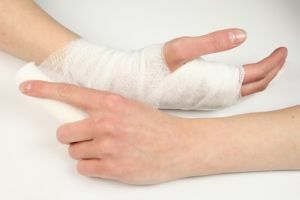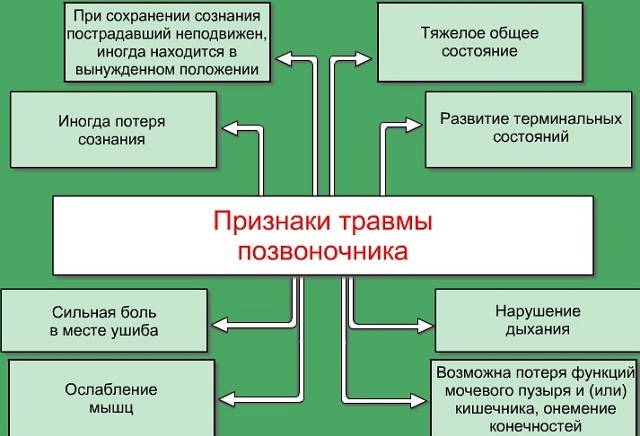 Most injuries to the musculoskeletal system must be accompanied by the immobilization of damaged bones or joints. One of the most common devices of the is the Dieterichs bus.
Most injuries to the musculoskeletal system must be accompanied by the immobilization of damaged bones or joints. One of the most common devices of the is the Dieterichs bus.
Fracture of the extremity is a very painful and often occurring phenomenon. Fracture of the lower limb is characterized by a high degree of pain and difficulty in the rehabilitation of the patient, since during correction of the consequences of a serious fracture, motor activity is excluded, which makes it more difficult for patients to receive positive treatment.
With regard to violations of the integrity of the hip and knee joint and fracture of the femur, they can be obtained not only by failing to fall or getting into a potentially life-threatening situation - often people of age get such an injury with normal movements.
The reason lies in the fragility of bone tissue, which occurs with age, when the danger of such damage is very high. Speaking about a fracture of the femur, it should be emphasized that this is a very difficult traumatic injury.
With such damages, the Diterichs bus is used, which excludes the development of the existing bone integrity disorder and allows for the effective treatment of , and also helps to provide assistance to the victim directly on the spot.
Contents of the article
- Why you need an
- device When using
- bus structure How to install the
- device What do you need to install the bus( toolkit)?
- Installation Process
- Installation Process
- Patient Reviews
- Patient Reviews How to buy and how much is the
- device Video: Diterich's Dreader Strip Overstay
Why is the
device Adaptable Dieterichs - a tire designed to immobilize the lower limbs, precedes the Cramer bus, consists offour parts: plantar, external, internal, and stick-twist with cord.
First proposed by the Soviet surgeon Dieterichs( 1871-1941), this tire was widely used during the Great Patriotic War as one of the main ways of transport immobilization, and is widely used today. An unconditional advantage of the Diterichs bus is that it simultaneously provides immobilization and extensibility of the ( traction) of the injured lower limb.
In some cases, the most common of which is damage to the femur, without its use, the further movement of the patient is strictly forbidden.
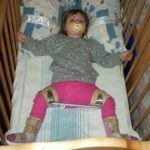 Why do you need a Vilnius bus and how to install and use the device? All the necessary information in our article.
Why do you need a Vilnius bus and how to install and use the device? All the necessary information in our article.
The most clear signs of a fracture of the finger on the arm appear in the first seconds after the injury. How to distinguish a broken finger from a bruise read here.
When
is used This bus is used to immobilize a thigh fracture , and is also used for various violations of the integrity of the hip and knee joint structure.
bus structure The original analogue consists of two wooden structures - external and internal, a special wide bar for fixing the foot and twisting, which is fastened to the bus with a cord.
Each of the designs resembling crutches, consists of two parts, which provides the ability to adjust the length of the tire, depending on the height and length of the victim's limb.
How to install the device
The Diterichs bus is applied directly after the inspection confirming the receipt of the corresponding injury. The installation procedure should be carried out as quickly as possible, and the technique of overlaying the tire must be rigorously honed.
What do I need to install a bus( toolkit)?
In addition to the tire, immobilization of the limb requires 2 bandages, scissors and additional bandages and cotton wool for dressings, which must be applied to the places where the joints protrude. It is desirable, if the situation permits, the subsequent fixing of the tire fixation by gypsum.
installation process The Diterichs bus application process involves many stages, each of which must be treated with the utmost care. Rules of application:
- First of all, it is important to calm the patient as much as possible, explain to him the essence of the upcoming manipulation with his body.
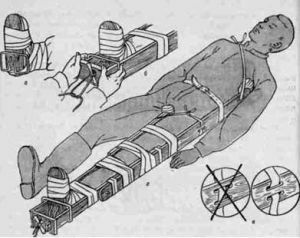
The photo shows how the Diterichs bus is applied when the lower extremity of the
- is broken. Cut the clothing on the seam if the clothing is tight against the injured limb, then carefully inspect the damage, making sure there is a fracture.
- Attach the inner and outer parts of the Diterichs tire to a healthy limb, fixing the desired length of the tire.
- Attach the plantar bar of the tire on the foot of the damaged limb of the patient using the eight-shaped dressing, making sure that the plantar part of the tire protrudes 8-10 cm beyond the plantar part of the foot.
- Insert the outer part of the tire into the metal anchorage of the sole.
- Place the inner part of the tire in the groin area from the side of the injured extremity, pass through the inner metal tab of the plantar part, and fasten the jumper of the plantar part.
- Insert a layer of cotton wool under the bony projections( ankles, knee joint, large trochanter and wing of the ilium) to prevent excessive compression and subsequent necrosis.
- Secure the belts from the armpit of the diseased limb to a healthy shoulder strap and at the hip level.
- Pass the cord through the hole in the jumper and thus attach the stick-twist. Twisting it, create a stretch of the leg, until the crossbeams are tucked into the inguinal and axillary areas.
- Lock the swivel stick behind the outer bar protrusion.
- Fix the tire on the injured limb, wrapping it in a bandage with the spiral strings of the bandage, leading from the ankle joint to the hip joint.
Technique for overlaying the Diterich's bus with a hip fracture on the video at the end of the article.
Things to remember when installing
When installing, it is important to remember the following:
- should be anesthetized before using the tire;
- it is necessary not to forget about imposing cotton-gauze pads on the tops of crutches of side flaps and in the area of the ankles of the shin in the case if the shoes are of soft material or absent;
- in case of fixation, not to the boot, but to the boot, fixing the sole part of the dressing should cover the top of the boot, in order to avoid sliding of the plantar component of the tire structure when stretched.
Knowledge of these details will help not only to correctly carry out the procedure, but also to avoid unnecessary pain for the patient.
Patient Reviews
According to the patients, the tire is very convenient and versatile due to the mobility of its design. Patients note that fixing by the tire helps to reduce the pain accompanying movement in the injured limb. Also, its prevalence and availability is noted.
Where to buy and how much is the
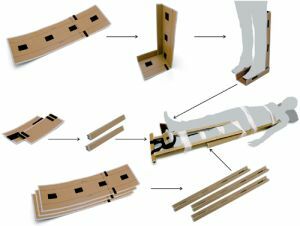 device. You can purchase Diterich's bus by contacting a request for an order for any company resource that sells medical equipment, the largest and most famous of which are in St. Petersburg and Moscow.
device. You can purchase Diterich's bus by contacting a request for an order for any company resource that sells medical equipment, the largest and most famous of which are in St. Petersburg and Moscow.
There are also a lot of announcements about single offers for the implementation of the Dieterichs bus across all Russian cities. The price of this type of equipment ranges from 400 to 700 rubles .depending on the materials from which it is made - it can be either a simple tire of the original sample, or an article made of modern materials and having a specific design.
Also, such equipment, of course, have injuries and organizations that provide medical services at the state and frequent levels.
A fracture is a trauma that can trap a person anywhere.
Knowledge of the features of the design and the rules for the use of appropriate equipment can reduce to zero the negative physiological and psychological consequences resulting from the receipt of a particular injury.
Since the injuries of the lower limbs, unfortunately, are not rare today, the information about the Dieterichs tire does not lose its relevance.
The ability to control the process of immobilization of the lower limb is useful not only for helping close people in a difficult situation, but also helps not to get lost in case of mass emergencies.
In the opinion of many physicians, trauma to the extremities themselves rarely have serious consequences. Complications often result in incorrect or absent fixation of the injured limb immediately before going to the hospital. That is why it is necessary to pay attention to the Dieterichs bus as a universal method of immobilization.

